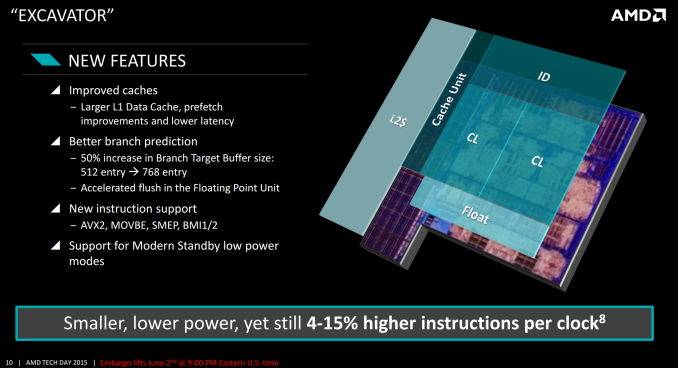AMD Launches Carrizo: The Laptop Leap of Efficiency and Architecture Updates
by Ian Cutress on June 2, 2015 9:00 PM ESTIPC Increases: Double L1 Data Cache, Better Branch Prediction
One of the biggest changes in the design is the increase in the L1 data cache, doubling its size from 64 KB to 128 KB while keeping the same efficiency. This is combined with a better prefetch pipeline and branch prediction to reduce the level of cache misses in the design. The L1 data cache is also now an 8-way associative design, but with the better branch prediction when needed it will only activate the one segment required and when possible power down the rest. This includes removing extra data from 64-bit word constructions. This reduces power consumption by up to 2x, along with better clock gating and minor adjustments. It is worth pointing out that doubling the L1 cache is not always easy – it needs to be close to the branch predictors and prefetch buffers in order to be effective, but it also requires space. By using the high density libraries this was achieved, as well as prioritizing lower level cache. Another element is the latency, which normally has to be increased when a cache increases in size, although AMD did not elaborate into how this was performed.
As listed above, the branch prediction benefits come about through a 50% increase in the BTB size. This allows the buffer to store more historic records of previous interactions, increasing the likelihood of a prefetch if similar work is in motion. If this requires floating point data, the FP port can initiate a quicker flush required to loop data back into the next command. Support for new instructions is not new, though AVX2 is something a number of high end software packages will be interested in using in the future.
These changes, according to AMD, relate to a 4-15% higher IPC for Excavator in Carrizo compared to Steamroller in Kaveri. This is perhaps a little more what we normally would expect from a generational increase (4-8% is more normal), but AMD likes to stress that this comes in addition to lower power consumption and with a reduced die area. As a result, at the same power Carrizo can have both an IPC advantage and a frequency advantage.
As a result, AMD states that for the same power, Cinebench single threaded results will go up 40% and multithreaded results up 55%. The benefits are fewer however the further up the power band you go despite the increase, as the higher density libraries perform slightly worse at higher power than Kaveri.












137 Comments
View All Comments
Cloakstar - Wednesday, June 3, 2015 - link
These scores definitely need validation. If true, Carrizo is a massive win.The FX 8800P graphic shows a 3DMark 11 score of nearly 2000 at 15W, and 2700+ at 35W.
The A10-7850k has a score of 2403 at 95W.
http://www.anandtech.com/show/7677/amd-kaveri-revi...
azazel1024 - Wednesday, June 3, 2015 - link
I didn't realize AMD's processors were so terrible at video playback. My 2 year old (pushing 3 now) Ivy Bridge i5-3317u equipped HP Envy 4t can manage roughly 6hrs of video playback of a 1080p h.264 12Mbps source and it only has about a 45whr battery in it. With a higher TDP chip and lots of "not power saving" features.creed3020 - Wednesday, June 3, 2015 - link
I am definitely in the market for one of these laptops to replace two older laptops in the house with one new one. If it had Carrizo for the hear I would be mighty happy to support AMD over Intel for this round, as the improvements here sound very much adequate for the system I am looking for.The ideal system would be something like the HP Spectre x360 for around $750.
michal1980 - Wednesday, June 3, 2015 - link
AMDs problem start with the 1st slide. "more people by notebooks priced between $400 and 700 than at any other price. Almost 2 out of every 5 notbooks sold is in that segment."umm, 3 out of 5 notebooks is sold outside of the 400-700 dollar price. Thats greater then 2 out of 5.
AMD fails math. Fails in general.
silverblue - Wednesday, June 3, 2015 - link
No. 3 out of 5 notebooks are either sold below $400, or above $700, and out of those two disparate segments, neither is as large as the $400 - $700 segment.There isn't a "math" fail here.
takeship - Wednesday, June 3, 2015 - link
The bigger issue is that AMD is admitting they are so uncompetitive in the market that it doesn't make business sense to chase at least 60% of consumers (and ignoring business costumers completely). And realistically, that 400-700 market is really more like a 550-700 market, as 400-500 is close enough to base iPad Air 2/premium Android tab pricing that you lose a lot of sales that direction.silverblue - Wednesday, June 3, 2015 - link
Surely TrustZone is a sign that they want business customers? Additionally, being able to work on the battery all day is a good thing.Gigaplex - Thursday, June 4, 2015 - link
Read closer. Their "all day battery" claim is being able to idle for 8 hours. You won't get a full work day out of that.silverblue - Friday, June 5, 2015 - link
If you class H264 1080p video as idle, sure. My fault for saying "work" though, however if all you're doing is light stuff, you won't be far off.FlushedBubblyJock - Wednesday, June 10, 2015 - link
for amd's sake we'll class idle as full screen video playback and 1.5 hours as all day, and no wifi bluetooth or dvd player active as full multimedia active -there, now look, you were correct ! your ego is in tact, you're never wrong
Calgon take me away